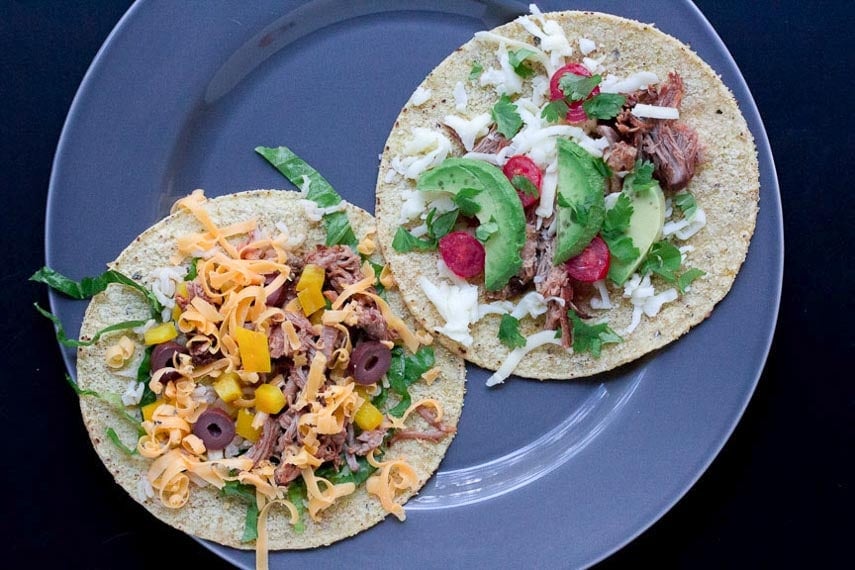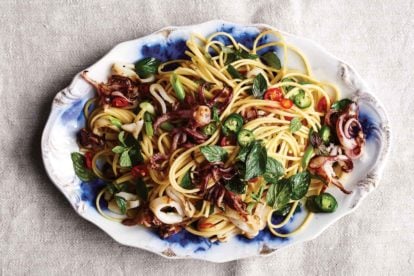We love pork and you can find many low FODMAP recipes here at FODMAP Everyday®, ranging from pork chops to meatballs to a wet-style Slow-Cooker Pork with Rhubarb BBQ Sauce. This Dry Rubbed Slow-Roasted Pork can be made in the oven with unattended cooking time.
Dry Rubbed Slow-Roasted Pork
It starts with rubbing a flavorful dry rub into the meat. That’s as complicated as this gets! You will be done with the prep in the time it takes for the oven to preheat.
The oven roast technique and the dry rub will leave you with some crispy bits and some tender, and they will all be juicy! We like to pile the succulent meat onto corn tortillas and then add low-FODMAP toppings as desired.
Check out our recipe for Slow Roasted Shredded Pork Tacos.
Is It A Shoulder Or A Butt?
Shopping for pork shoulder can be confusing. You might find a hunk of meat that looks like a shoulder, but is labeled as “butt” or “Boston butt”. This is actually cut from the top of the pig’s shoulder, forming a somewhat rectangular hunk of well-marbled meat.
It is called a “butt” because in decades past, pork was often packed for storage or shipment in wooden casks called “butts” while during the same historical time period, Boston based butchers developed a signature way of cutting the shoulder, hence the name “Boston butt”.
We prefer bone-in, for added flavor, but you could use boned. If you can only fine a cut labeled “picnic shoulder”, you can use it but it will not be quite as tender.
Note that the roasting time is about an hour per pound; adjust accordingly as your piece of meat might vary in weight.
Temperature & Cuts Of Pork
This is a great time to discuss various cuts of pork. There are 3 factors to take into consideration: the cut of the pork, the USDA recommendations and what chefs and home cooks can actually do that yields delicious and safe results.
Let’s start with the USDA, which is a governmental agency concerned with food safety. They used to suggest cooking all pork to 160°F(71°C) for safety in regard to bacteria, parasites, etc.. They amended that to only needing to be 145°F(63°C) along with a 3-minute rest. This has saved many people from overcooking lean cuts of pork such as pork loin and chops. If you think you don’t like pork, perhaps you have only eaten toughened overcooked pork!
A lean pork loin, however, is a far cry from a fatty, marbled pork shoulder or pork butt. These cuts, as in this recipe, are often cooked for extended periods of time, and in order for the collagen to break down, bringing them to a temperature of at least 200°F(95°C) – and I find a sweet spot at about 209°F(98°C) – is often suggested. These higher temperatures with these fatty cuts, and a low cooking temperature, yields succulent results.

Dry Rubbed Slow-Roasted Pork
This Dry Rubbed Slow-Roasted Pork has a very short prep time and then a long cooking time in the oven, but it is unattended, making this dish very easy to make. Just budget in your time!
Ingredients:
- 2 tablespoons kosher salt
- 1 tablespoon firmly packed light brown sugar
- 1 tablespoon freshly ground black pepper
- 1 tablespoon dry mustard
- 1 tablespoon paprika
- 1 tablespoon smoked paprika
- 1 teaspoon ground chipotle pepper
- 1 teaspoon cumin
- 5 to 6 pound (2.3 kg to 2.7 kg) bone-in pork shoulder (butt), at room temperature
Preparation:
-
Position rack in center of oven. Preheat oven to 300°F (150°C). Have ready a large roasting pan.
-
Stir together the salt, brown sugar, black pepper, mustard, paprika, smoked paprika, chipotle pepper and cumin in a small bowl. Use hands to thoroughly rub into the pork, covering every surface including over any fat cap and under any flaps of meat or fat.
-
Place meat in roasting pan, fat cap down (see Tips) and roast for about 6 hours. Check with an instant read thermometer, cooking meat until it reaches at least 145°F (63°C). Test to see if if shreds readily. It might be quite there until it hits about 200°F (95°C). The meat will take about an hour a pound, give or take a little, depending on how cold the meat was when you placed it in the oven. Allow the meat to rest at least 20 minutes for the juices to redistribute. Simply shred meat using two forks, pull apart with your fingers or chop into hunks with a knife.
Notes:
Tips
- I had always roasted my pork shoulders and Boston butts with the fat cap (the fatty layer) on the underside. But then I got to thinking about how the fat could act as a self-basting mechanism if it were allowed to drip down from on top. After much research and experimentation I found that some folks do indeed like to roast with the fat on top for just such a reason, but what you lose are the extra crispy bits that develop with this dry rub and fat on the bottom approach. Your choice.
- The USDA recommends internal temperatures for ground pork to be 160°F/71°C and other cuts of pork to 145°F/63°C. Personally, I like my hamburgers rare, my lamb very pink and my pork cooked just enough, as it is in this recipe. Trichinosis, which is the parasite that people are concerned with in pork, is killed when meat is frozen and also when it is exposed to temperatures above 131°F/56°C. We feel safe recommending removing the pork from the oven at 145°F/63°C for this recipe. Also note that during the resting period, the temperature will continue to rise a bit but with this kind of dish, that’s okay.
Nutrition
All nutritional information is based on third-party calculations and should be considered estimates. Actual nutritional content will vary with brands used, measuring methods, portion sizes and more. For a more detailed explanation, please read our article Understanding The Nutrition Panel Within Our Recipes.











This was so delicious! The whole family loved it! I used a boneless pork shoulder roast.
I decided to try starting the meat fat side up to get the juicy drippings all over and the flipped it after an hour or two to have fat side down. I have no idea if this made a difference or not, but it was so good!
Also, I wasn’t sure if I was supposed to cook with lid on or off. I did it in my large cast enamel dutch oven. I started with lid off to get it crispy awesomeness and then when I flipped it over I put the lid on to keep it juicy and tender. It cooked faster than I expected also. Maybe because I had the lid on…We enjoyed it on buns and next I’ll use the leftovers to make tacos or pupusas. Yummy! Thanks for the recipe!
Hi Kathryn! Yes, my approach is in a large roasting pan, so no lid involved, but sounds like you got a good result anyway! Thank you for letting us know. Love the ideas of leftovers on buns! This recipe is MEANT for the leftovers, I think.
I’m new to low fodmap cooking and the rub recipe looks great! However.. in my experience pulled pork doesn’t “pull” until it reaches over 200F. It’s likely safe to eat at 145F but it’s not going to shred properly.
Doug, thank you for writing. In general, yes, I absolutely agree with you. For whatever reason this pork was fork tender at 145F as you can see in the images and since the point of this dish, in large part, was to provide ways to reuse during the week I knew the pork was going to get reheated and I didn’t want to overdo it. However, the discussion of temperatures and various cuts of pork is something that I am going to add to this recipe. It will be edited and thank you for bringing this up. This recipe was written rather early on when I was not expounding as much in the headnotes. This will be a great addition.